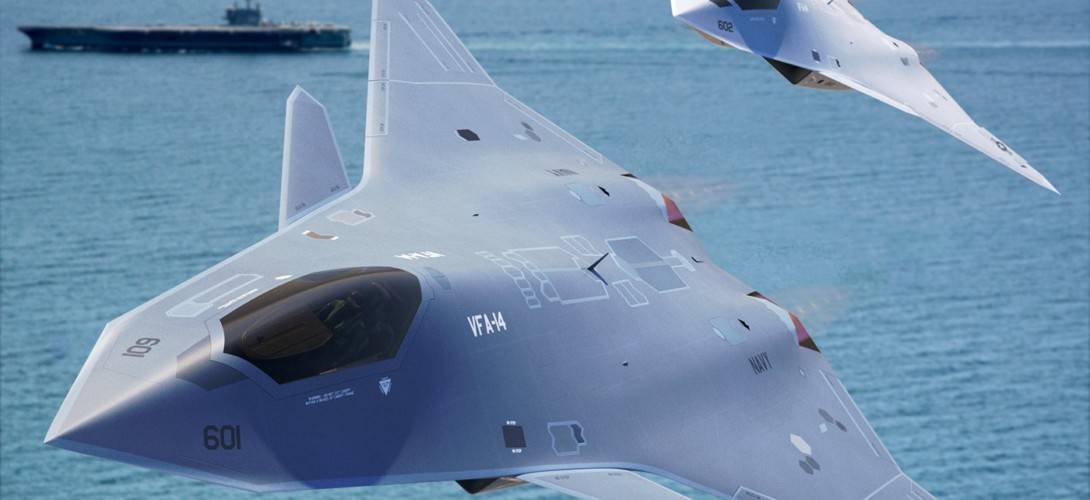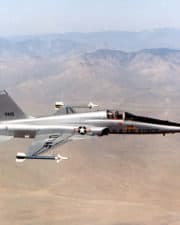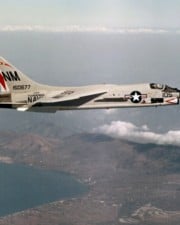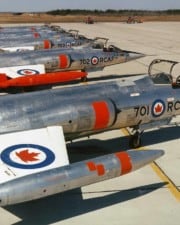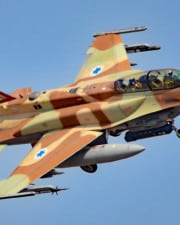The future is now, especially in the world of aeronautics, which is why it should come as no surprise that the fighter jets of the future are already in development with powers and abilities that we cannot yet quantify, or perhaps even imagine. So what does the future hold?
Table of Contents
It can be hard to make any kind of definitive statement about sixth-generation fighters, in large part because, as stated above, the technology that is set to make the future of aerial combat go hasn’t yet gotten off the ground itself in many cases.
Some of this technology builds on extant state-of-the-art tech used in fifth-generation fighters. However, some of it is still in its early stages of research and development, and some is merely conceptual at this point.
It is also worth noting that sixth-generation fighter jets are in large part a response to the current military and political state of play. While military technology, as with all technology, is on a constant march forward, that march has been accelerated by international and regional tensions.
It should come as no surprise, therefore, that the fighter jets on this list are all being produced by nations caught up in international conflicts or quasi-cold wars. From three-way rivalry between the US, Russia, and China to the EU and UK’s military interests to Japan and India’s wary eye at China, Pakistan, and other threats, sixth-generation jets are part of a new arms race.
These are the top nine Sixth-Generation Fighter Jets currently in development, in no particular order.
1. HAL AMCA (India)

The AMCA is a fifth-generation fighter for the Indian Air Force that is planned to eventually have sixth-generation capabilities. Initial research has been completed and the fighter is scheduled to be displayed in 2024, with prototypes and the first test flight arranged for 2025, and manufacturing for 2030.
Because it is a fifth-generation fighter that is destined to be upgraded to a sixth-generation one, this fighter jet, while still in the developmental stages, is still further along with more concrete specifications to list.
The AMC is expected to measure 56 feet 5 inches long, be able to reach Mach 2.15, have an operational range of 1750 nautical miles, and be armed with several kinds of armaments, including laser-guided bombs, a 23mm GSh-23 cannon, S-8 rocket pods, Astra Mark 1/2/3 air-to-air missiles and BrahMos NG air-to-ground missiles.
2. Mitsubishi F-X (Japan)

This proposed stealth fighter for Japan’s Air Force is still in development, with the timeframe for its mass production released in July 2020. The project aims to have a prototype ready for 2024, test flights in 2028, and, if all goes well, regular manufacturing could begin by 2031.
The F-X will likely feature stealth technology, including plasma stealth antenna, which can be used to deflect radio waves, thus making it harder for radar to detect it. While it can deflect radar, however, the antenna will still allow for communication while it’s activated.
Bearing the nickname “Godzilla,” it does not have official specifications yet, but some believe that it will be bigger than the F-22, may be built with X-2 capabilities, and perhaps even be able to be armed with more missiles than the F-35. It will also feature XF9-1 engines.
3. MiG-41 (Russia)
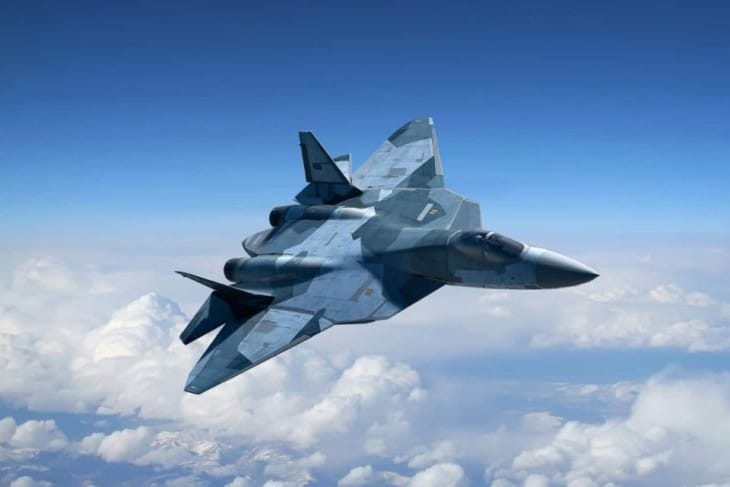
Being manufactured by Russian aviation mainstay Mikoyan and also known as the PAK-DP, the MiG-41 is planned to be either an extremely advanced fifth-generation-or sixth generation fighter jet. It is expected to have stealth capabilities and be able to exceed Mach 4.
When completed, this will replace the long-serving MiG-31s that serve as part of the core of Russia’s Air Force but were last produced in 1994. The MiG-41 design was completed in 2019, tests were conducted in 2020, and, by January 2021, it entered its development phase.
The MiG-41 is planned to have a missile interceptor system that will be able to intercept not just conventional missiles but hypersonic ones as well. Assuming that everything continues to go according to plan, the MiG-41’s mass production is at present scheduled for 2025.
4. Future Combat Air System (EU)

The FCAS is a proposed sixth-generation fighter system for nations in the European Union. It is to be built by Airbus, with Germany, France, and Spain the chief countries investing in the program, which will have both manned as well as unmanned elements.
The program began in 2017, Dassault Aviation and Airbus were announced as collaborators for the project in 2018, Safran and MTU joined in 2019, and, by 2020, the first phase of research and development on the FCAS was approved by the budgetary committee of the Bundestag.
Still, the FCAS is a long way off, with it not expected to be in use until 2040. When it’s completed, it is expected to have stealth features, advanced avionics and situational awareness, novel effectors, and electronic warfare and directed energy weapon capabilities.
5. F/-XX (USA)

The United States Air Force is regularly on the cutting edge of fighter jet technology, and this is the case here too, as the USAF leads the race for sixth-generation fighters. The F/X-XX is planned to someday replace some of the United States Air Force’s current repertoire of fighters.
Concept drawings in 2018 depicted a sleek craft with high-energy lasers that may even be able to slice through its future adversaries. Such are the futuristic fantasies made reality of sixth-generation fighters, though it’s far closer to fantasy than reality now, with no producer and little to no concrete information available.
This doesn’t mean that the USAF isn’t pushing forward towards that future as fast as possible, however – in September 2020, a prototype of an unknown fighter jet was test flown for the first time.
6. Tempest (UK)
This proposed sixth-generation fighter for the Royal Air Force has also attracted interest from Sweden and Italy. It is scheduled to be introduced by 2035, but is already impacting Britons’ pocket books now. In 2018, it was reported that two billion pounds would be spent on it by 2025.
However, there are economic arguments in favor of the Tempest as well. For example, Team Tempest asserts it could help the manufacturing sector, promising to infuse 25 billion pounds into the UK economy and bring around 20,000 jobs per year from 2026 to 2050.
The Tempest will be able to control drones, utilize futuristic technologies for their radar systems, and have access to a world of data that would provide pilots with a comprehensive view of the world and targets around them.
7. J-XX (China)
If there is any country that can give the USAF a run for its money in terms of aerial dominance, it’s China. A combination of the project still being in the early planning stages and the Chinese government naturally being tight-lipped about new military projects means that not much is known about this proposed sixth generation fighter.
Whatever the J-XX is or becomes, it will someday replace the J-20 and J-31, both of which are new and closely guarded secrets. As a result, ideas of what it may include come primarily via Chinese announcements via state media such as China Central Television.
Among CCTV’s rumors and rumblings are that the J-XX may have a longer fuselage than previous designs, may have a trapezoidal wing, and may have an “S”-shaped air inlet in order to reduce its radar signature.
8. I3 (Japan)
The I3 is still in the early stages of development for the Japanese Armed Forces. It is imagined to be the successor to the F-2 Fighter, and is part of a larger attempt by the Japanese Armed Forces to modernize their military with neighboring Russia and China doing the same.
However, while it is imagined as someday replacing the F-2, the influence of the latter on the former is still unclear, as is the precise timetable for this replacement occurring. That’s partly because this model is at the beginning of its lifecycle, with research to begin in the early 2020s.
Among the potential features of the I3 are advanced stealth technology, resistance to electromagnetic and electronic interference and warfare, AESA radar, advanced avionics, sensor fusion, and, just as with the Tempest, the promise for directed energy weaponry and anti-missile capability.
9. T-5 Trainer (Taiwan)

While not technically necessarily a sixth-generation fighter, the T-5 Trainer is seen as Taiwan’s first step towards such a jet as they continue to renew and advance their aviation program. This has become more necessary of late due to new threats of invasions from China.
Prior to this, Taiwan had relied mainly on the F-CK-1. However, these fighter jets were first introduced in 1994, and can thus be seen as aging and potentially no match for both China’s current set of advanced fifth-generation fighters as well as sixth-generation possibilities such as the J-XX.
As for the T-5 Trainer itself, it had its first test flight on 10 June 2020. Compared to the F-CK-1, the T-5 Trainer will have the same engine but 80% new parts, increased fuel capacity, advanced avionics, and a slightly larger body.
Related Posts
